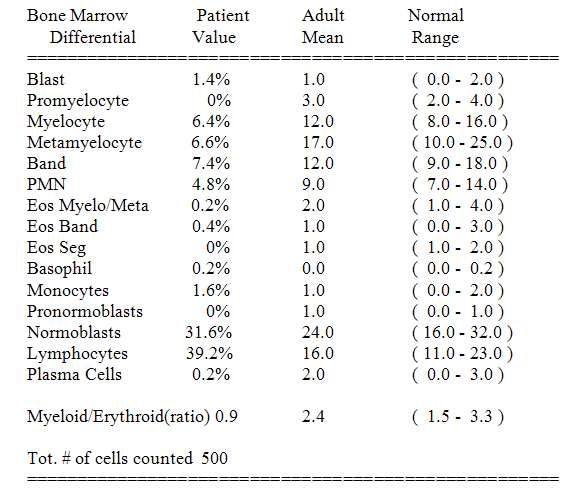
![]() Contributed by Faye Gao, MD, PhD and Lydia C. Contis, MD
Contributed by Faye Gao, MD, PhD and Lydia C. Contis, MD
CLINICAL HISTORY:
A 36-year old male presented to the hospital with an ear infection. Laboratory studies drawn in the emergency department demonstrated a pancytopenia including neutropenia. He was admitted to the hospital where he underwent an extensive workup including viral testing for hepatitis B, hepatitis C, and HIV, all of which were negative. Imaging of the sinuses was negative for acute or chronic sinusitis. His past medical history was significant for testicular cancer diagnosed at the age of 23. He is status post left orchiectomy and radiation therapy. He was in his usual state of health until approximately 3 months ago when he started having episodes of night sweats. Physical examination was significant for splenomegaly that measured approximately 3 fingerbreadths below the costal margin. The peripheral blood smear demonstrated anisocytosis, ovalocytes, polychromasia and tear drops. Atypical lymphoid cells were identified with rounded nuclear contours and hairy cytoplasmic projections (Figure 1). Platelets were reduced.

A bone marrow biopsy and aspirate were performed along with flow cytometry studies and cytogenetic studies.
BONE MARROW, BIOPSY AND ASPIRATE:
The marrow aspirate smears were hemodilute. The differential was performed on the touch imprint (Figure 2):

The marrow is normocellular for age (50% cellular) (Figure 3). The myeloid:erythroid ratio is mildly decreased. Myeloid and erythroid maturation are complete and sequential. Megakaryocytes are present with no significant morphologic abnormalities. Small lymphoid cells with abundant cytoplasm are noted in the touch imprint. There are focal lymphoid infiltrates seen in the bone marrow biopsy which are comprised of small to intermediate sized lymphoid cells with an oval or indented nucleus and abundant cytoplasm and a "fried-egg" appearance. Iron stores are present based on the iron stain performed on the bone marrow biopsy. Reticulin stain shows increased reticulin fibrosis (Figure 4). The bony trabeculae are unremarkable.
ANCILLARY STUDIES:
Immunohistochemical stains performed on the bone marrow biopsy demonstrated an infiltrate of B-cells which were CD20 positive, cyclin D1 positive, CD5 negative, and Annexin A1 positive (Figures 5 and 6).
FLOW CYTOMETRY:
Flow cytometry studies performed on the bone marrow were inconclusive due to low cell counts. Flow cytometric immunophenotypic studies performed on the peripheral blood demonstrated a B-cell population with the following aberrant phenotype:
Kappa light chain restricted, bright CD19+, CD20+, CD5 (-), CD10 (-), CD103 (-), bright CD11c+, CD25+, CD20+ and accounting for approximately 7% of total cells analyzed. Blasts were not identified (Figures 7 and 8).
CYTOGENETIC STUDIES:
Cytogenetic studies performed for this case show an apparently normal male bone marrow chromosome analysis in a limited specimen which yielded only 12 metaphases (46,XY[12]).